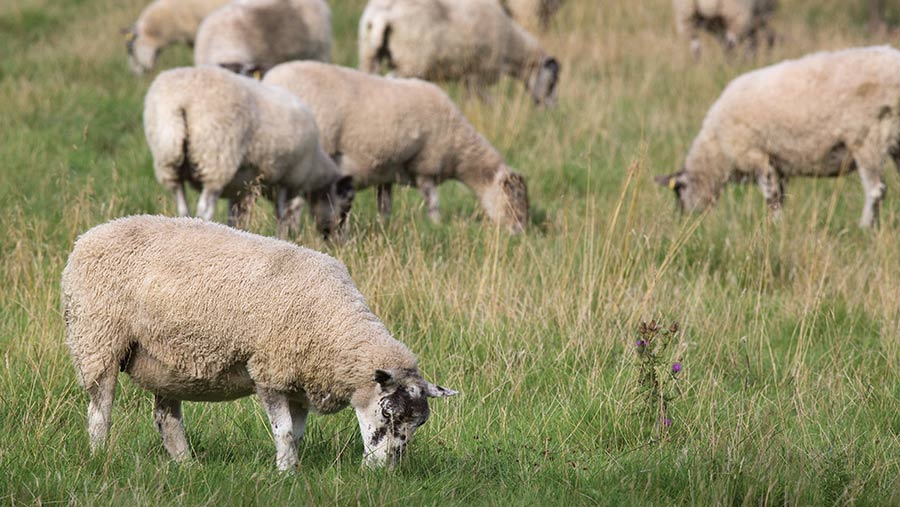8 steps for cleaner grazing to reduce worm burden
 © Tim Scrivener
© Tim Scrivener It is well known that the problem of worms in lambs (parasitic gastroenteritis – PGE) leads to losses through reduced growth and death, and it has been estimated the annual cost of this problem is £84m.
While wormers remain an essential tool in the armoury against gastrointestinal parasites, worm resistance to these products is increasing and so other methods need to be considered.
One approach to reduce the burden of worms in pasture is cleaner grazing, a method that requires some forward planning.
Ben Strugnell, an independent vet who runs postmortem business, Farm Post Mortems, says: “The best news is that many of these strategies do not cost anything; they just require a few tweaks in the flow of sheep.
See also: A guide to effective wormer use to reduce resistance risk
“Concentrate on one or two extra fields each year and try to reduce the worm burden on them by changing where sheep move when.”
“Now is the time to start planning for next spring to try to reduce the worm burden of pastures that lambs will be turned on to,” he adds.
Risk levels for pastures at different grazing times |
|||
|
|
High-risk pasture (red) |
Medium-risk pasture (orange) |
Low-risk pasture (green) |
|
If grazed in spring |
|
|
|
|
If grazed in summer |
|
|
|
|
If grazed late in the season or in autumn
|
|
|
|
|
Source: SCOPS |
|||
He explains the eight key factors to consider at this time of year:
1. The risk of any pasture depends on the time of year you plan to graze it and what has happened on that pasture in the year before it is grazed by lambs. Proper “clean pasture” needs to be free of ewes and lambs for a lot longer than most people think.
For a low risk, a pasture virtually needs not to have had any sheep on it at all for the entire preceding year. For most people, this is difficult to achieve. The following table gives a risk factor based on the time of year you plan to graze:
2. Cattle and non-lactating ewes can hoover up worm eggs on pastures and do not themselves shed eggs that can infect lambs, so these are a good way of cleaning up pastures for lambs. However, it takes a few months for this to make a significant difference.
3. Not having sheep on a field means worms hatch out, are not eaten, and die, thus reducing the overall infectious load for lambs.
4. Probably the best way of increasing the worm burden of spring pastures for ewes and lambs, which you don’t want to do, is to put store lambs on them until late into the winter. So now is the time to think about where you put those lambs.
If they go on land intended for cutting next spring, their impact will be lower.
5. Late summer is a good time to find a map of your farm and colour in all pastures as they will be next spring, so that the worm risk can be managed. For many farms, most of the fields will be red (in correlation with the Scops table, above).
However, with some careful planning ahead, it may be possible to change some fields to orange or even green (medium or low risk) over a few years.
6. It is also a good time to plan where dry ewes will go post weaning and for tupping. These will hoover up worms, and if they can be removed from such pastures before it is too late for grass to re-grow before spring then some spring pastures with a medium risk may be created.
7. Strongly consider selling lambs as stores if prices are good, as this will reduce the worm burden for next year and enable you to colour some fields in orange or green for some of the next grazing season.
8. The other point to consider now is to establish which worms on your farm are sensitive and resistant to which wormers. It is important to do a drench test/ faecal egg count reduction test (FECRT) initially at two different times of the year – late spring and autumn, to get the picture.
You may even find that your worms are less resistant than average, which means again you can save money by using a cheaper wormer.
Ben Strugnell is an independent vet in County Durham. He worked in mixed practice in North Yorkshire for five years, specialising in farm animals.
Mr Strugnell then went on to work for the Veterinary Laboratory Agency in Thirsk, where he developed his skills in pathology and his belief that an accurate postmortem can diagnose the majority of diseases in farm animals and can prevent unnecessary losses and improve productivity on farm.
He now runs the Farm Post Mortems service.
